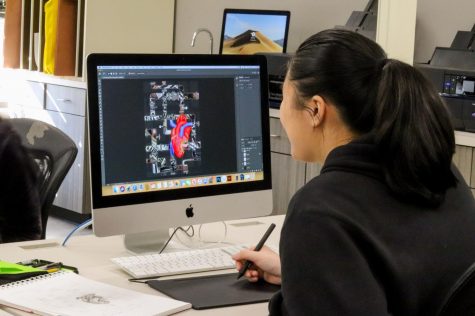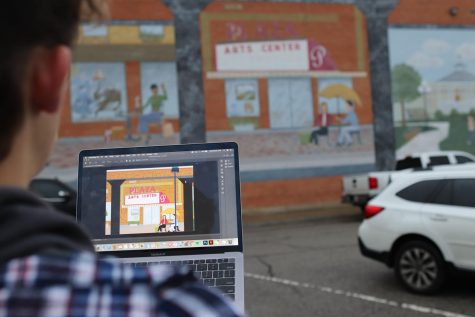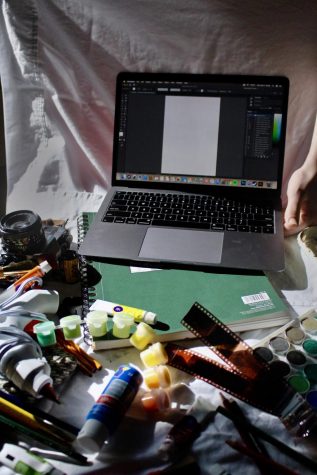Next generation of artists flourishing through evolving visual design fields
March 1, 2020
Bold strokes of vivid color. Clean, orderly lines sweeping from top to bottom. A cursor tracing the edges of an object. A screen, a mouse and a hand. This is the modern reality of art.
In a rapidly changing society entranced by technology, art has transformed into a digitized hybrid “that encompasses artworks created with new media technologies”. Thanks to these modernized innovations, the art world has evolved, allowing for previously unimaginable new possibilities for budding artists and demanding consumers alike.
A foundational stepping stone
Many aspiring artists begin their computer or digital art experience from a young age. At Coppell High School, students are offered numerous classes focusing on aspects of the tech art field. The most common are art teacher Cameron Tiede’s, under the arts and humanities endorsement pathway. Digital arts and media is the class that most closely matches careers in art and tech, as it introduces students to both Adobe Photoshop and Illustrator, two of the most commonly used tools by industry professionals, using assignments inspired by real world projects. Having worked for Michael’s and freelanced for the industry for seven to eight years, Tiede uses his own experiences to give students the skill set required to succeed in the field.
“[Digital arts and media] is not so much a class about learning the tool,” Tiede said. “It’s a class about design and about storytelling. The computer is just like a pencil – it’s a tool. It’s what you bring to it and what you do with it that matters.”
After digital arts and media, students have the option to go into AP 2-D Design, which largely focuses on design principles and concepts used in art and tech industries. Most use the computer for their 15-piece portfolio, but students are expected to already have sufficient knowledge of software through the preceding class.

Using drawings and notes from her sketchbook, Coppell High School junior Sidney Sun utilizes a Wacom tablet to create a portfolio piece for her AP 2-D Design class. Digital art has become a more popular medium in the art world throughout the last few decades, creating a new platform for artists.
While these classes have a heavy emphasis on the fine arts, Career and Technical Education teacher Cynthia Wolfe’s classes, graphic design and illustration, animation and digital media, put a technical spin on the same subject. Rather than delving straight into the Adobe Creative Cloud, the students start out using Microsoft PowerPoint, creating illustrations and motion graphics in the presentation software.
“A lot of kids get overwhelmed when they open Adobe products because there’s a lot going on,” Wolfe said. “In Graphic Design, we use the pen tool in PowerPoint first. Then when we open Illustrator and use the pen tool. It’s a lot simpler because it’s the same thing, with just a little tweaking.”
As much of digitized art requires an equal portion of both art and science, the computer science classes at CHS give students essential knowledge in programming, algorithms and hardware. Computer science teacher Michael McCabe heads beginner level computer science principles, while Michael Finnegan heads more advanced classes programming I and II, AP Computer Science A and practicum.
For 2019 CHS graduate Alyssa Aguilar, also Sidekick staff designer Kaylee Aguilar’s older sister, who is now a freshman in the Arts & Entertainment Technologies major at the University of Texas at Austin, the fine arts and engineering classes she took throughout high school gave her the tools necessary to be on the path to success in her major.
“When I was trying to choose a major around junior year, I was kind of stuck, because I was in the engineering program at CHS and I just wasn’t feeling that engineering was for me,” Aguilar said. “At the same time, I was enjoying art a lot, but I couldn’t see myself doing pure studio art in future. I found [the Arts & Entertainment Technologies] program and it was a perfect integration between engineering and art. It was perfect for me.”
Aguilar now plans to do a certificate in computer science alongside her current study of game design, allowing her to turn her own visions into realities without the aid of technical specialists.
“Because I was aiming to do art that is more technical, I thought especially for game development, having a computer science background is really important, even more important than knowing how to draw or do art,” Aguilar said. “Especially when you’re on a team with both software engineers and pure studio artists, you’re kind of almost acting as the bridge between those two.”
University of Southern California graduate Sagar Ramesh, who graduated from CHS in 2015, works as a product designer at virtual reality company Oculus’s headquarters in Menlo Park, Calif. During his time at Coppell, Ramesh took fine arts classes including AP Drawing, but only actively decided to go into art as a career after college counselors from USC, CalArts and other schools visited CHS during his sophomore year.
“Initially, because I come from a fine arts background, I understood it wouldn’t be practical to continue doing fine arts,” Ramesh said. “A lot of my peers and people who are older than me ended up going into animation, so I started seeing animation as a viable path.”
Though he initially planned to study film animation, he found his calling in virtual reality and learned computer science, so he would be able to bring his ideas to life on his own.
“When I started as an artist, I had a strong grasp on [an] idea I wanted to manifest into something real,” Ramesh said. “But until I was able to do it myself, I was always dependent on someone else to do it. So learning how to code or learning how to build things in AR (augmented reality) and VR just allowed me to build better things overall.”
A modernized perception
Though digitized art has evolved to suit modern times, first strides in the emerging field occurred years in the 1960s with the advent of new technologies, such as the digital camera and the computer. Suddenly, it became evident art did not only have to be created using physical mediums – the up-and-coming inventions of the time could serve a similar purpose.

Digital design programs such as Adobe Photoshop can be used to recreate physical pieces of art, including this mural in Downtown Carrollton depicting the Plaza Arts Center. Digital art has become a more popular medium in the art world throughout the last few decades, creating a new platform for artists.
Despite its technical intricacies, the movement is far from inaccessible to the general public. The forerunner of the digital art movement since 1982, Adobe Inc. offers a wide range of programs through the Adobe Creative Cloud which specialize in different subsects of digital art, including CHS’s preferred Illustrator and Photoshop. While these focus on a more technical aspect, software such as Clip Studio Paint and iPad app Procreate allow for more artistic work that mimics traditional artwork. Digital sculpting and virtual three-dimensional models can also be created with tools like Autodesk Maya (which was used by the“Stranger Things” team to create realistic animations) and Blender. Adobe also offers an animation tool, Adobe After Effects, to create motion graphics.
Because of the growing popularity of the field, artists can more easily find success and job opportunities. As dependent as modern society is on technology, the tech industry rakes in millions of dollars, making the hybrids of virtual reality and graphic design, among others, increasingly lucrative. Since such careers are so specialized, the demand for experienced artists to aid in the design aspect of a company is high. Even outside tech, artists who work for studios such as Pixar or Dreamworks can amass a hefty annual income, as their services are so in-demand.
“Before, art was a lot more competitive,” Ramesh said. “Just because a lot of the work was subjective, a lot of people were basically competing for the same job. Whereas now, thanks to the internet and a lot of other distribution platforms, it’s a lot easier for artists to make work or draw attention to themselves, because they basically own their own distribution.”
Independent artists can also find success, though typically to a lesser extent, through the use of platforms such as Patreon and Gumroad, where artists can sell directly to their fans through e-commerce. Artists can also simply share work through social media, getting their name out there to garner a following before opening up shops or starting commissions.
“The really unique thing about technology is it just scales way more than something that’s physical,” Ramesh said. “Something that appears on [social media] can be reached by a million people, whereas something that appears in a museum might only be accessed by maybe thousands of people. People who work in art or tech realize how powerful technology is, just for the distribution, so that’s where a lot of the people here are coming from. That’s why tech is so appealing.”
Looking to the future
As a rapidly evolving industry, the possibilities under the computerized field are limitless. Now, people can interact with art unlike ever before. Interactive installations allow people to actively experience art, as though the entire space is the art piece. Projection mapping transforms 3-D structures, visuals wrapping around complex figures to create larger-than-life art pieces. Virtual reality brings people to new and exciting worlds and augmented reality adds unique features to our world.
With virtual reality exploding in popularity, things previously thought to be impossible are coming true. Virtual production allows filmmakers to create motion capture films, seeing the actors in a virtual world while acting on a special stage. This technology enabled director Jon Favreau to direct The Lion King (2019), where all the characters are computer-generated.

There are many different mediums used in art, both physical and digital. Digital art has become a more popular medium in the art world throughout the last few decades, creating a new platform for artists.
As more obstacles are being challenged with the aid of rapidly growing technology, the hardware, too, evolves to keep up, creating a positive feedback loop of growth and evolution, where things only consistently get better and better.
“If it wasn’t for art, we wouldn’t have the hardware that we do today,” Finnegan said. “There’s nothing that’s pushed hardware harder and faster than art through games. Because we don’t need this kind of power to run Excel or Word. We push the hardware limits with entertainment, with visuals within games, and that’s all art.”
However, rapid change can pose a challenge as well, as sudden developments can turn an entire industry upside down. When a new technology completely upstages a thriving industry, the people in it can find themselves in a difficult position.
“When I was freelancing years ago, I was doing a lot of [Adobe] Flash video games,” Tiede said. “I would do the animation and artwork. I’d put it all together and they would turn it into a video game. But then the iPhone came out and Flash all went away. Where you could make a lot of money one day or one year suddenly all dried up right away. And when you put a whole bunch of work and time and effort into something and then it just disappears, that makes it really difficult.”
However, a strong skill set and background can combat sudden changes, allowing higher adaptability as artists can transition into whatever the industry currently presents and what people want.
“People love the idea of visual communication and stories and there’s far more of that going on now in the world than there ever used to be,” Tiede said. “There’s endless opportunities for it, but human nature will still be the same. We’ll still want to read, we’ll still want to tell stories, we’ll still want games and movies and all the things that we as creatives can still feed people. It just might be in a completely different way.”
As long as people continue to crave artistic experiences and bring their own skills to the plate, the art world can see numerous developments and transform based off the future may bring.
Follow Shravya Mahesh (@shravyamahesh) and @CHSCampusNews on Twitter.













